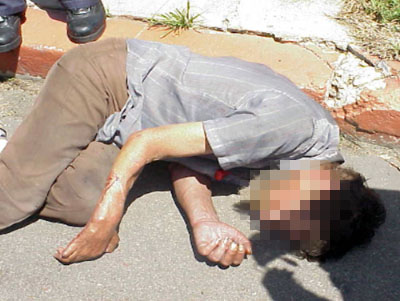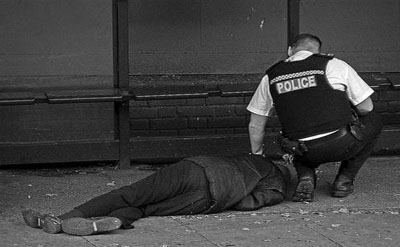
A person is "found down" and 911 is called…
A source of tremendous frustration as Emergency Medical Services Crew members transport the same person to hospital Emergency Departments many times in a month, sometimes several times in a single day.
Summary of the Problem - the impact of 529 specifically identified individuals (homeless, alcoholic, usually with other medical and mental illness as well):
- From 2000 -2003
- 308 (58%) were transported by EMS 2,335 times
- 409 (77%) amassed 3,318 Emergency Department visits
- 217 (41%) required 652 hospital admissions
- Resulting in 3,361 inpatient days
- Health care charges totaled $17.7 million
- Payments for only 18% of charges were received

The end result was that the community's Emergency Services and Hospitals lost many millions of dollars per year and with little, if any, benefit for those suffering the devastation of chronic alcoholism, chronic mental illness, chronic medical illness, homelessness, or all of those conditions together. The status quo was a very expensive, non-productive approach, and something had to change.
(The summary below was adapted from the City of San Diego's Community & Economic Development Department 2004 Statement on SIP)
Started in January 2000, the Serial Inebriate Program is an innovative effort involving the City and County of San Diego, the San Diego Police and Sheriff's Departments, San Diego County Superior Courts, San Diego County Health and Human Services and Mental Health Systems, Inc. The program serves as a problem-solving effort to reduce the number of chronic, homeless alcoholics going in and out of Detoxification Centers, County Jail, and local emergency rooms through intervention and treatment. A number of agencies and treatment partners work in tandem with SIP. This collaborative effort provides a less expensive and more appropriate alternative to emergency departments and jails for treatment of homeless chronic inebriates.

The goals of the Serial Inebriate Program (SIP) are:
- to slow or stop the revolving door cycle of chronic alcoholics going in and out of Detoxification Centers, County Jail, and Emergency Rooms
- to divert this population off the street and into County-funded treatment programs
- to significantly reduce the uncompensated costs, time constraints, and manpower burdens to San Diego County's healthcare, law enforcement, and judicial infrastructure caused by homeless, chronic alcoholics
- to give people who routinely live on the street an opportunity to create a stable mainstream lifestyle
The program strategy offers treatment in a joint City/County-funded program in lieu of custody time obtained from a guilty verdict for public intoxication (California PC 647(f) ). Once in treatment, clients are provided with wraparound services designed to help their recovery from alcoholism and begin moving them toward re-entering society as a sober community member.

"SDPD began this program because it reduced the number of repeat offenders," said San Diego Police Chief William Lansdowne. "With about 7,000 chronically homeless people in the county, SIP dramatically impacts the number of hours that law enforcement officers have to spend on alcohol and other issues involving those who live on the streets."
From its inception through September 2004, SIP secured tangible results that have improved the lives of program participants while reducing the burden taxpayers incur through police, hospital and emergency costs. 32% of clients entering the Serial Inebriate Program complete the program. Moreover, a study by the San Diego Police Department's Western Division showed that individual arrests were down 12%, total arrests were down 33%, and arrests per person were down 25% for Serial Inebriate Program clients.
On September 14, 2004, Mr. Philip Mangano, Executive Director of the U.S. Interagency Council on Homelessness, remarked, "In moving forward with a 10-year planning partnership focused on ending homeless for the most vulnerable and costly, and in developing cost effective innovative initiatives such as the SIP program, the San Diego region is in the national forefront in its response to homelessness."
The San Diego area has more than more than 7,300 urban homeless and 2,300 rural homeless in this region, including homeless men, women and children, as reported in the most recent Regional Task Force on the Homeless Profile (October 2006). Of these, it is estimated that family members make up approximately 39% of the urban homeless population. With the City's current complement of 3,400 year-round shelter beds, there is a gap of nearly 4,000 beds for the City alone.
A chronically homeless person is defined as one who has a significant disability and other challenges that cause him or her to routinely live on the streets. These include a diagnosable substance use disorder, serious mental illness, developmental disability and chronic physical illness or disability. They most often sleep in a place not meant for human habitation (e.g., street, canyon, park, or vehicle) and/or in emergency homeless shelters continuously for at least a year or experience four episodes of homelessness in the past three years. They are sometimes referred to as the "visible" homeless.

There are also chronically homeless families that routinely live in emergency or short-term homeless shelters in the San Diego region, 60% of which are children. The County's Health & Human Services Agency is currently working to develop data on the actual number of chronically homeless families.
The County of San Diego's Serial Inebriate Program (SIP) has won a state award for reducing the use of public resources by chronic alcoholics. SIP won the award for Outstanding Achievements in the Alcohol and Drug field from the County Alcohol and Drug Program Administrators Association of California at the association's annual dinner in Sacramento on May 28, 2008. (http://www.sdcounty.ca.gov/Portal/News/060608serialinebriate.html)
"This program helps people who badly need help and saves taxpayers money," said Chairman Greg Cox, of the San Diego County Board of Supervisors. "It's another example of how a partnership between the City and the County can benefit the public."
"The success of SIP is due to the great collaboration between all the agencies involved," said Susan Bower, Director of Alcohol and Drug Services (ADS) for the County's Health and Human Services Agency. "We are delighted to see that the program has been a success and that our efforts are being recognized."
According to SIP research, between 2000 and 2003, a total of 308 homeless alcoholics had to be transported to two local hospitals costing nearly $1.3 million, of which only $176,715 (13 %) was recovered. A subsequent study revealed a 50 percent reduction in use of emergency resources by this population.

